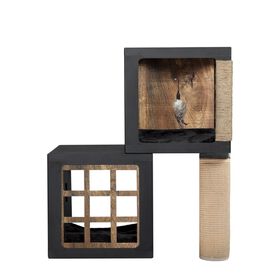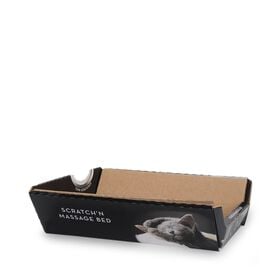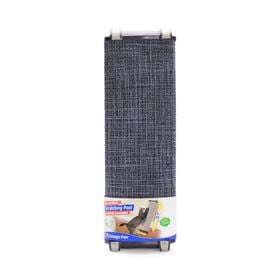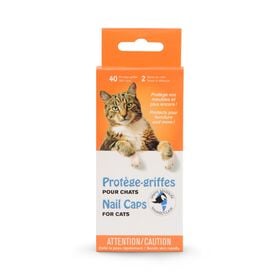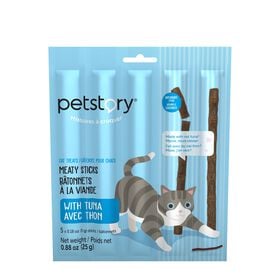Is your cat scratching up your furniture all over the house? Don’t worry: there are answers, and we have them!
A lot of owners report their cats ignoring the beautiful scratching post they bought them, and many think it’s because the accessory is simply not designed for their pet. What usually follows is that the couch becomes the cat’s primary target. This is typically the time when owners lose patience and consider de-clawing their cat, or worse, abandoning them. However, the problem isn’t the cat itself, but an inadequate or improperly placed scratching post.
If you purchase a quality scratching post and strategically place it, there is very little risk that your cat will attack the sofa or the door frame. If, however, your cat has already made the sofa their scratching post, rest assured that this can be easily remedied.
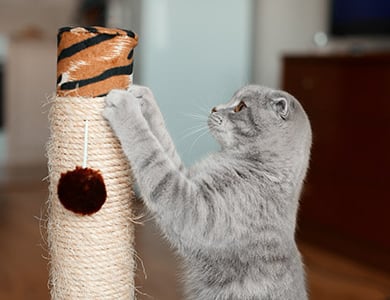
The elements of an ideal scratching post
When giving your cat a scratching post, make sure it satisfies the following criteria:
- Solidity. Most people will go for the least expensive scratching post. These are often not stable enough and fall over upon contact with your cat’s paw. Because a scratching post is meant as a stand-in for a tree, it’s important that it be as stable as possible—if not, your cat will surely ignore it. This is often the main reason cats stay away from scratching posts. If you’ve purchased a scratching post that isn’t sufficiently stable, try sliding the base of it beneath the couch: this will not only stabilize the scratching post, but will also ensure it is properly located. In doing this, you not only save a few dollars, but also help ensure your scratching post is getting used!
- Height. Your scratching post must be elevated enough to give your cat a good back stretch. For a normally-sized cat, the scratching post must be at the same height or slightly higher than a coffee table.
- Placement. Your scratching post must be properly placed. Your cat doesn’t arbitrarily choose where to sharpen his claws; it’s almost as if the spot were marked with a “private property” sign. This spot is typically located at the entrance to their area or near resting areas, hence why placing scratching post on the opposite side of a room in an effort to maintain decor is totally counter-productive. This will usually result in your cat scratching the corner of the sofa at the entrance to the room instead of the scratching post on the opposite side of it. Door frames will often become targets for this same reason.
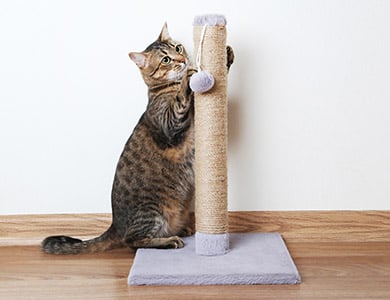
A few different models of scratching posts
A lot of cats enjoy horizontal scratching posts, and they’re the ones who should choose from a rug, a piece of board or any one of the many games that exist to this effect. There are also a number of inclined scratching posts and even wall scratchers which can be temporarily placed on the corner of the couch. These are generally highly effective. Most cat trees consist of posts which allow your cat to scratch its claws while at the same time enriching their environment.
Teaching your cat not to scratch your furniture: 3 easy steps
- Give them an area in which to sharpen their claws. Punishing your cat for doing something completely natural doesn’t help anyone. It’s best that you place a scratching post in the area they are likely to sharpen their claws.
- Cover the corner of the couch temporarily with aluminum paper, plastic or ribbon with glue on both sides (double-sided tape): doing so will make the area a less desirable scratching location. Three weeks should suffice.
- Playing with your cat or using some cat grass or treats are good ways of getting them to place their claws on the new scratching post.
After a few weeks, remove the plastic; by that point, your cat should opt for the scratching post. If not, it may be because the sight of their scratch marks on the sofa or even the texture of the sofa itself is more attractive to them that the scratching post. In this case, it is recommended that you get the sofa repaired, sand the affected wood, or cover the scratching post with a material similar to that of your furniture. This will give your cat another perfectly satisfactory option.
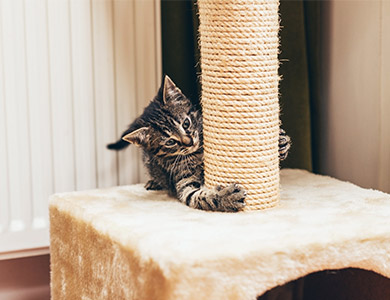
Another option: Nail caps!
Nail caps or nail covers are small cases that are placed on the claws. They stay in place for anywhere from three weeks to three months. Most vets can put them on for you and show you how to do it at home. Nail caps are basically envelopes which round out the tips of your cat’s claws, which means your cat can scratch anything they want without damaging anything.
NB: Be sure that the nail caps are properly placed. Also, remember that not all cats tolerate them well. We strongly recommend contacting a vet after first placing the nail caps: this way, you will have the right information, and will help ensure the experience is a positive one.
A few changes that can be made
Lastly, if your cat is sharpening its claws on the furniture instead of on the scratching post, this can be a sign that something needs to be changed. Scratching posts are still the best solution, but nail caps and covering your furniture and are other options as well. If the situation doesn’t resolve itself, you can always contact a feline behavioural specialist, such as the Éduchateur —they will be able to give you some advice. After all, as you will surely see for yourself, for every problem, there’s a solution!


